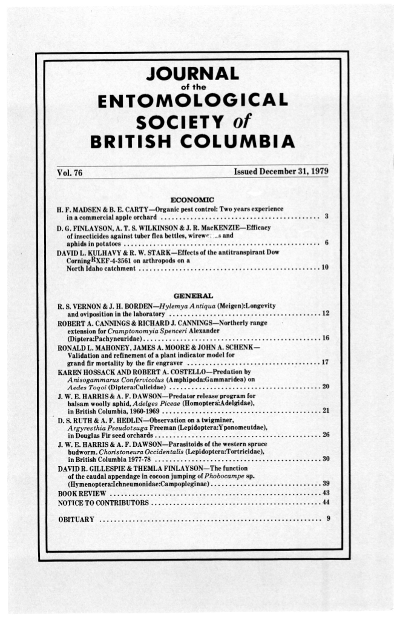Validation and refinement of a plant indicator model for grand fir mortality by the fir engraver
Keywords:
grand fir, fir engraver, <i>Abies grandis</i>, <i>Scolytus ventralis</i>, understorey plants, linear regression, indicator plantsAbstract
A previously developed plant indicator model that estimates grand fir mortality by the fir engraver was tested in 7 grand fir stands. The observed and predicted mortality levels were similar in 5 of the test stands for trees killed during a 3-year period. A better statistical fit was achieved by refining the model and its parameters based on a combined set of data from the original and test stands.
References
Moore, J.A., J.A. Schenk, and C.R. Hatch. 1978. Validation and refinement of a hazard rating model for fir engraver-caused mortality in grand fir stands. Forest Sci. 24: 309-312.
Partridge, A.D. and D.L. Miller. 1972. Bark beetles and root rots related in Idaho conifers. Plant Disease Reptr. 56:498-500.
Schenk, J.A., J.A. Moore, D.L. Adams, and R.L. Mahoney. 1977. A preliminary hazard rating of grand fir stands for mortality by the fir engraver. Forest Sci. 23:103-110.
Schenk, J.A., R.L. Mahoney, J.A. Moore, and D.L. Adams. 1976. Understory plants as indicators of grand fir mortality due to the fir engraver. J. Entomol. Soc. Brit. Columbia 73:21-24.
Downloads
Published
Issue
Section
License
Authors who publish with the Journal of the Entomological Society of British Columbia agree to the following terms:
-Authors retain copyright and grant the journal right of first publication with the work simultaneously licensed under a Creative Commons Attribution License that allows others to share the work with an acknowledgement of the work's authorship and initial publication in this journal.
-Authors are able to enter into separate, additional contractual arrangements for the non-exclusive distribution of the journal's published version of the work (e.g., post it to an institutional repository or publish it in a book), with an acknowledgement of its initial publication in this journal.
-Authors are permitted and encouraged to post their work online (e.g., in institutional repositories or on their website) prior to and during the submission process, as it can lead to productive exchanges, as well as earlier and greater citation of published work (See The Effect of Open Access).


